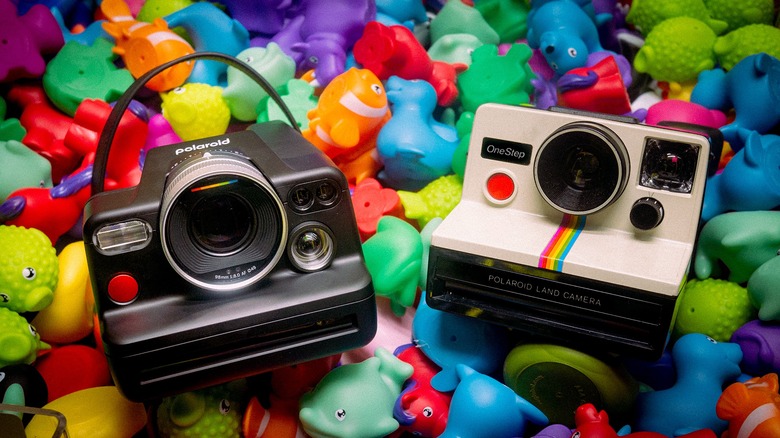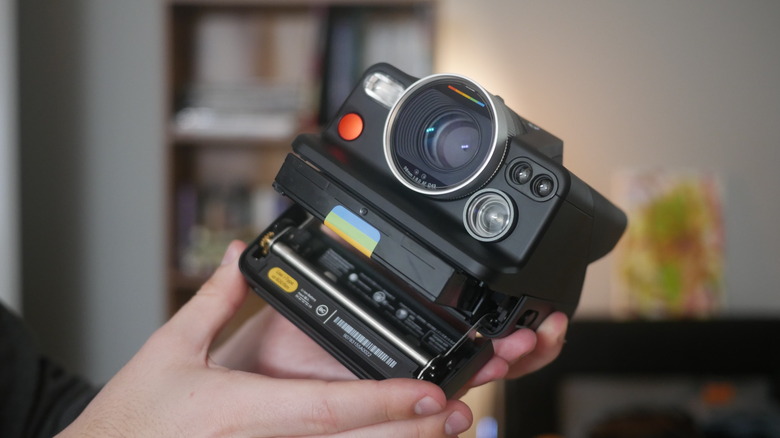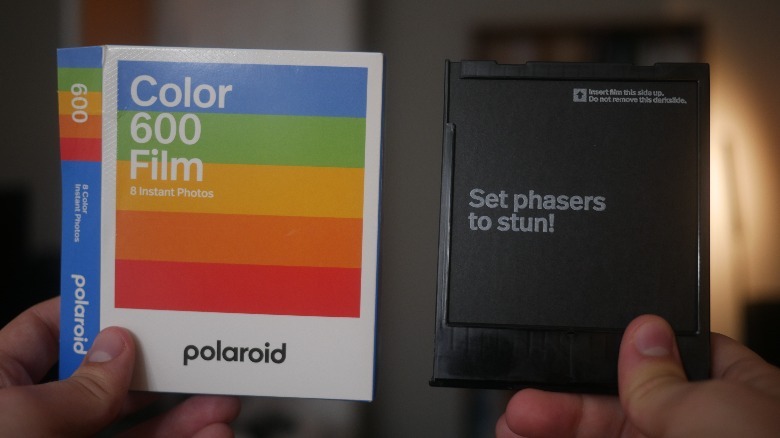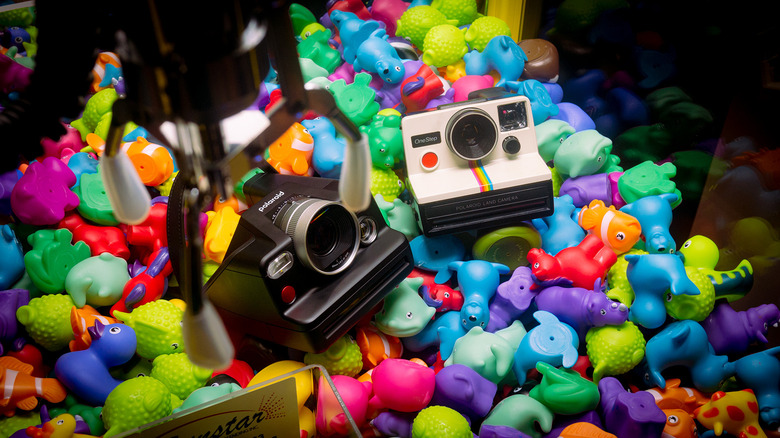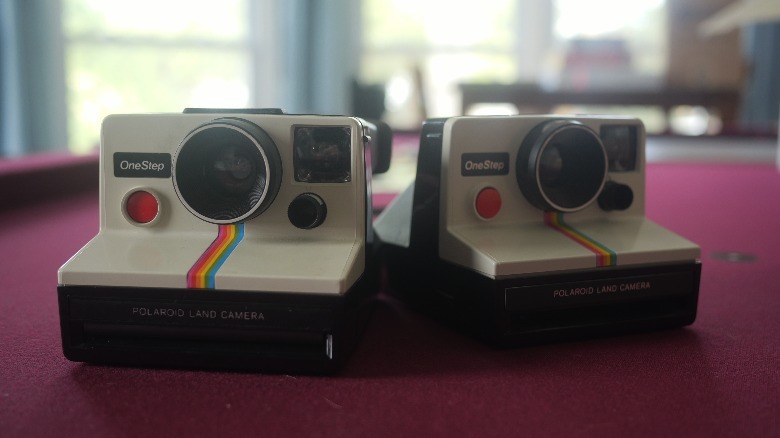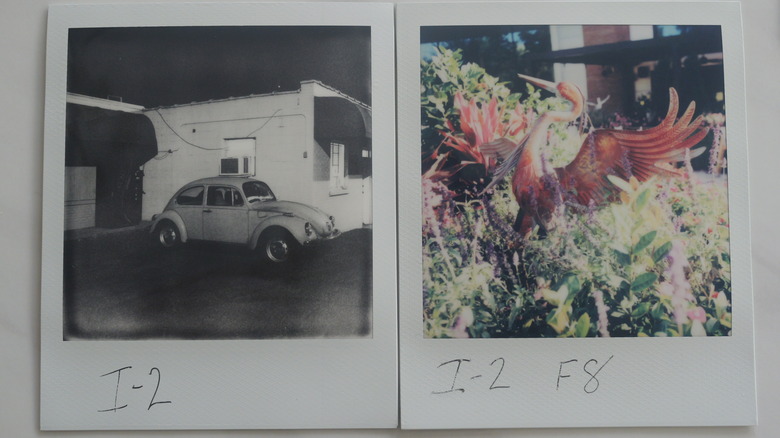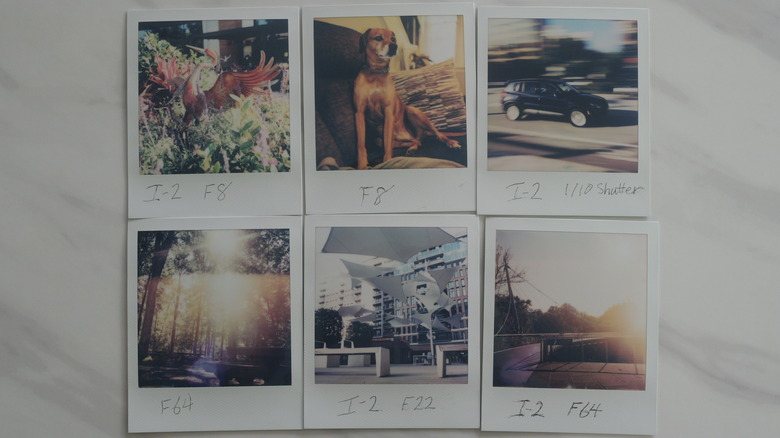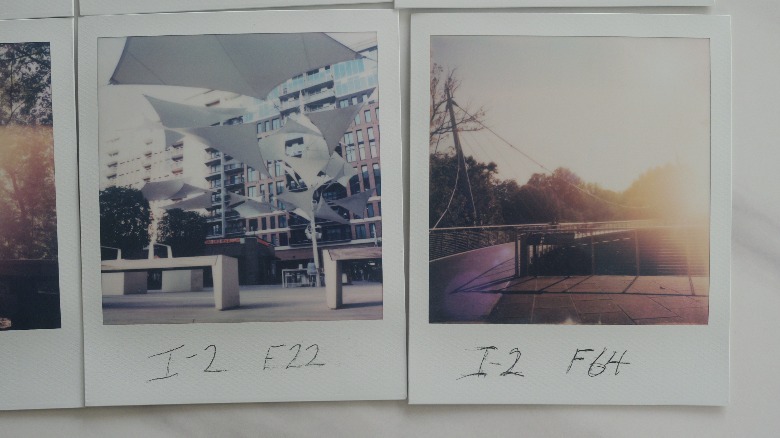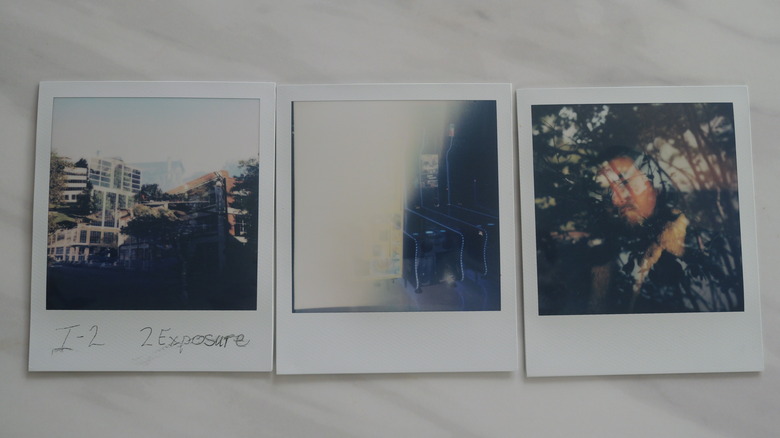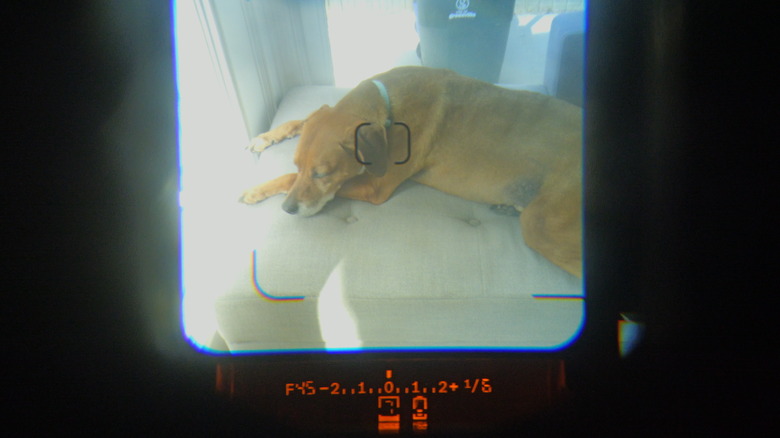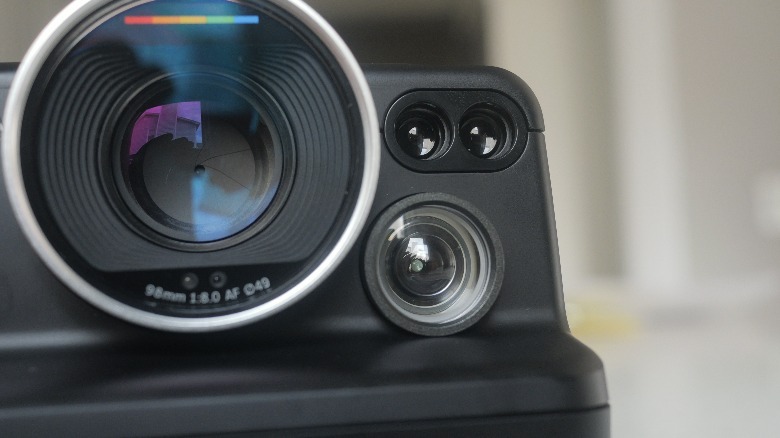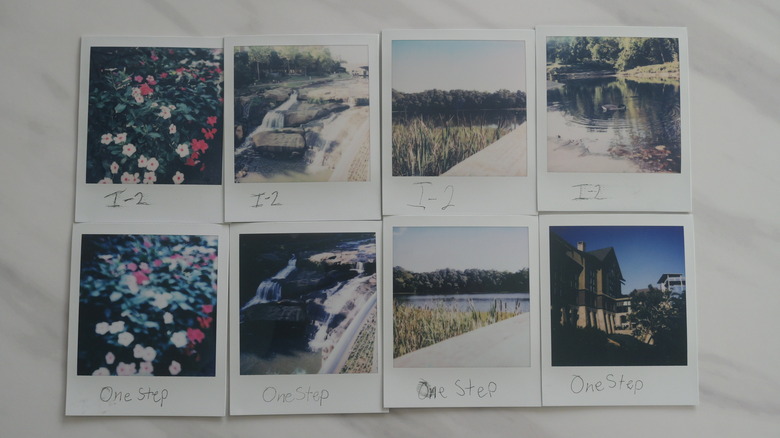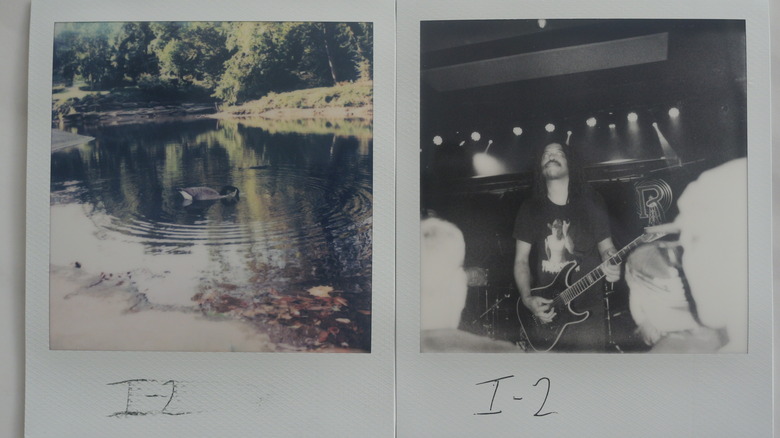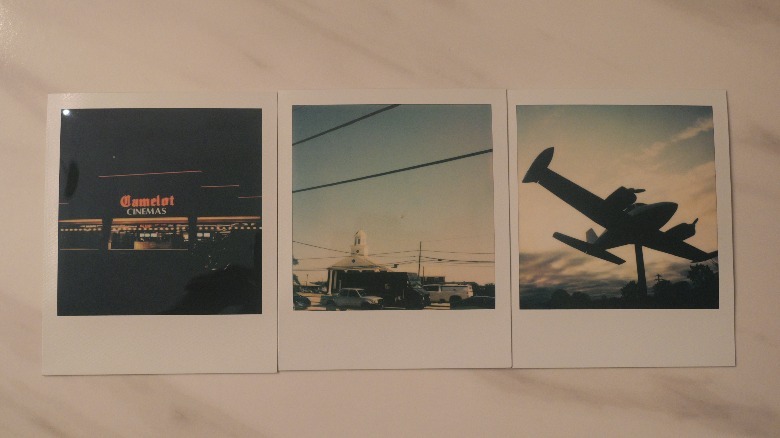A Blast From The Past: How Polaroid's New I-2 Revives The Spirit Of The 1980s
We may receive a commission on purchases made from links.
Through the decades, Polaroid has created some of the most iconic film camera designs in history, the most recognizable of which is probably the SX-70 OneStep produced through the 1980s. The squared-off body and rainbow-on-gray color scheme is likely the first thing that comes to your mind when you hear the word "Polaroid," even though the company has produced plenty of models before and since that time. It's this iconic design that drove us to pick a OneStep up at a thrift shop for $10. However, this camera mostly sits on the shelf as a decoration, because our experience using the thing has been a complete letdown. It's so easy to screw up an exposure with the old Polaroid, and at $20 per eight-pack of film, every mistake is costly.
The new I-2 camera could be the solution to this problem. It promises a modern, advanced light metering system with priority controls, and a sonar autofocusing system to ensure photos come out sharp every time. As such, we put these two cameras up against each other to see how much progress has been made with the Polaroid instant system in the past 40 years. Considering the I-2 comes with a $600 price tag, it better run circles around this thrift shop find. To find out, Polaroid loaned us the new camera along with a few packs of color and monochrome 600 film.
Getting started with the Polaroid I-2
Loading up the I-2 with film is an extremely similar experience to what you have on the old school Polaroid. Both cameras use the same medium-format film size. The OneStep is made to meter for less sensitive SX-70 film, while the I-2 is compatible with SX-70, 600, and i-Type film. We would recommend loading i-Type into this camera because the I-2 does not require the battery cartridge present in SX-70 and 600 packs. i-Type uses the same film as 600, but is a bit cheaper to purchase, and probably better for the environment. The lower sensitivity of SX-70 film will also make it less versatile in this camera, but it might come in handy for long exposures in daylight.
To load the film, open the bottom door using the release switch and insert a fresh film pack, using the printed guide arrows as reference. Do not remove the paper cover on top of the cartridge. This is known as the dark slide, and protects the film from exposure before loading. Once the pack is loaded, the camera's motor will automatically activate and spit out the dark slide. You now have eight exposures ready to go.
After taking your first shot, the plastic "frog tongue" attachment will catch the print and shield it from sunlight. Remove the photo from the I-2 and place it somewhere dark. Despite being marketed as instant, the Polaroid photo will take about 15 minutes in order to develop fully.
Design and build quality
Looking at these cameras side by side, it's easy to see the shared DNA. Both have the same basic shape, and use similar roller printing systems. However, the build quality on the I-2 feels miles better. Both bodies are plastic, but the I-2 has a solid weight to it while the OneStep feels cheap and hollow. The matte black finish of the new camera seems resistant to knicks and scratches, while the old one will get scuffed up if you stare at it too long. The I-2 uses an internal battery, and charges over USB-C. One charge will get you through several film packs before needing to plug in.
Reliability is always a concern with the classic Polaroids. For all we know, they've been sitting in hot, dusty garages for decades. Part of the reason we didn't like to use the SX-70 was because the rollers really like to ham. For the sake of this article, we purchased a second identical OneStep in seemingly better condition for about $12, and this one didn't jam.
We can't vouch for how reliable the I-2 will be in 40 years, but we can say that several film packs ran through it and not one jammed. While not using the camera, we would recommend storing it in a covered bag to stop dust from getting into the rollers. We would also give the internal rollers of any used Polaroid a quick wipe down with isopropyl alcohol and a Q-tip, letting it dry before loading new film.
What's new on the I-2?
Apart from the previously mentioned autofocus and metering, the I-2 has a few more quality-of-life improvements over the old school OneStep. Along the bottom is a standard tripod mount. We would recommend bringing a tripod along with the camera if you plan on taking night shots, or even shots in shade, as it may be the only way to eliminate unwanted motion blur in your exposure. The only way to fix the old camera to a tripod is with a roll of duct tape. The I-2 also gains a built-in flash, while the SX-70 requires an external flash accessory. This flash can be a lifesaver when it comes to taking handheld shots indoors, or adding some fill light to backlit subjects.
The lenses on each of these cameras are quite different. The I-2 uses a 98mm lens with a maximum aperture of F8. Since Polaroid film is a medium-format, you get about a 40mm equivalent field of view and F2.8 aperture. The classic OneStep uses a 103mm lens with an F14.6 aperture and focus fixed at infinity. These differences mean that the I-2 lens will be much better in low light, sharper while taking landscapes, and can close-focus on subjects. The I-2 lens also has a 49mm filter thread, while the OneStep has no convenient system for lens filters.
Exposure settings
While the old OneStep, and most other Polaroid cameras, are automatic exposure only, the I-2 features a variety of modes to get the exact picture that you want. The modes as they appear on the tiny LCD display are: auto, aperture priority, shutter priority, manual, multi-exposure, and timer. In multi-exposure and timer modes, metering is also handled fully automatically. Like most cameras, we had the I-2 in aperture priority most of the time, and we'd recommend avoiding manual unless you're a real pro. Polaroid film lacks the dynamic range of 35mm negatives or modern digital sensors, and does not take kindly to anything but neutral exposure. For this reason, we also recommend leaving the exposure compensation switch near zero.
In manual and semi-manual modes, the dial around the lens is used to adjust aperture and shutter speed. The lens isn't quite sharp wide open, so we'd close it down at least one stop if light permits. For the sharpest landscapes, bring a tripod and close it down to the narrowest setting of F64. The shutter speeds available on the I-2 go from 1/250 of a second at the fastest and 30 seconds at the slowest.
This shutter is fast enough to snap photos in daylight conditions without any real need for a neutral density filter. Polaroid color film is balanced for daylight, so shaded areas will appear blue and indoor lighting will be overly yellow. Some blue and yellow lens filters can correct for this.
Multi-exposure and app control
The weirdest of the I-2's various modes is definitely multi-exposure. This setting lets the photographer composite two to four exposures on one print, a technique that would require violently jamming the film back into body of the SX-70. We tried to do double exposures a few times, and weren't thrilled with the results. This is really something to try only if you're feeling experimental — the two exposures often clash in unappealing ways, and highlights get blown out easily. The only one that turned out semi-well looks like it would be a rejected promo for "Twin Peaks."
It's rare that we're impressed by a camera's smartphone integration, but this Polaroid app has given us the least number of headaches out of any we've tested recently. It connects to the camera over Bluetooth instantly, and it never dropped this connection throughout our testing. Through the app, every single menu control is available on your phone, except for the exposure compensation switch. The app is also used to periodically update the I-2's firmware.
This smartphone connection is amazing for self-portraits and tripod work, because you can remote activate the shutter without any worry of bumping the camera and ruining the shot. The I-2 does have a 3.5mm port for a wired shutter remote, but this app makes that wholly unneeded.
Viewfinder and focusing system
The finest viewfinder that you can get on a Polaroid system is probably on the vintage folding SX-70, which this 1980s OneStep is based on. The original SX-70 used a reflex viewfinder, and a mirror mechanism like a professional SLR. Both the OneStep and the I-2 use independent viewfinders that are offset from the picture-taking lens, and that means that the framing in the viewfinder is not exactly what you get in the photo. The I-2 includes some handy frame guides in order to give you a better understanding of what the lens sees.
This I-2 viewfinder is much bigger and brighter than the one on the OneStep, but the viewing angle is quite poor. You need to have your eye lined up with it perfectly in order to see what you're aiming at. The sonar focus sensors for the camera are positioned right above the viewfinder lens, while the sensors for the light meter are on the picture-taking lens itself. This means that in close-up shots there may be a discrepancy between the focus point of the camera and the metering point, so avoid heavily backlit portraits.
With no reflex lens, there is no manual focus option for the I-2. Instead, the camera tells you the focus distance in meters, which is displayed inside the viewfinder alongside exposure information. Eight meters is the maximum focus distance, and what you want for landscapes. Minimum focus is at 0.4 meters, and the manual recommends half a meter distance for portraits.
Image quality vs. old-school Polaroid
Despite using similar film stocks, the I-2 boasts better image quality than the SX-70 OneStep by a wide margin. It seems that it boils down to the much more advanced metering system in the new camera and the sharper lens. In daylight, the I-2 will give you a usable exposure nearly every time, and it works at night with a tripod. With the OneStep, it's difficult to nearly-impossible to get a single totally satisfactory photo out of it. It seemed to underexpose shots no matter how it was used, and that could be a side effect of its age. When it was new in 1982, it may have performed better, but it's hard to say for sure.
Close focus is also non-existent on the OneStep, although updated models from the 90's did add autofocus to fix this. With the I-2, you're able to get near your subject and get medium-format depth of field with nice soft background blur. We also tried adding close-focus diopters to the filter thread in order to enhance this effect even more, but these seemed to interfere with the metering sensor and didn't turn out well.
The variety of shutter speeds available let the photographer freeze motion in daylight, and take time lapses and night shots that wouldn't be feasible on a lot of other instant film camera systems. This is really a versatile camera, given the limitations of the film that it's built for.
Polaroid I-2 verdict
We had a ton of fun with the I-2, but we have to grade it against its $600 price. You can get an decent used pro camera for that kind of money, and a Polaroid is closer to a toy than a professional tool. The I-2 is for people who really want to shoot instant film, and want the best possible image in that format. Polaroid veterans of the 1980s and beyond will probably fall in love with this thing.
Even though the old OneStep was a $10 investment, the results it delivered were still unsatisfactory. Polaroid film itself isn't cheap, and every bad photo wastes a couple bucks. If you plan on running a ton of film through one of these, then the new camera could actually be a more frugal option. Of course, there are cheaper ways to dip your toe into the hobby in the modern day. The current Polaroid Now retails at $120, while the smaller format Polaroid Go is $100. The Fujifilm Instax Mini 12 is also $80. Any of those may be worth looking at if the I-2 is outside your price range.
Overall, it's easy to appreciate the way that instant film makes one think differently about photography. We felt like we were in touch with the tradition of a pioneer like Ansel Adams, doing our best to make every shot count, packing the tripod, stepping down the camera lens, and waiting minutes for the sun to dip into the perfect spot of the frame. In that way, the I-2 can give you a brand-new perspective. You can purchase the Polaroid I-2 at Best Buy for approximately $600 right now.
